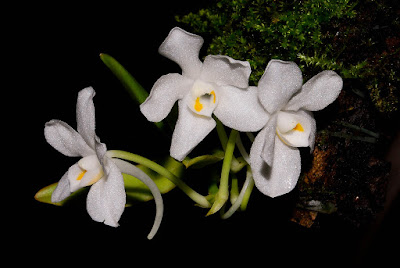Amesiella minor is found in the Philippines, where it grows on trees in mountain forests at an altitude of 1000-2000 meters...
Amesiella minor also called as The Minor Amesiella, is a species of the genus Amesiella. This species was described by Karlheinz Senghas in 1999.
IDENTIFY AMESIELLA MINOR
Amesiella minor is found in the Philippines, where it grows on trees in mountain forests at an altitude of 1000-2000 meters.
It is a mini-miniature sized, cool growing epiphyte, which reaching 2-5 cm in height, with a few to several, thick, leathery, fleshy, paler beneath, conduplicate, narrowly oblong to elliptic, obtuse to falcate, 10-12 cm long leaves.
The Minor Amesiella blooms in the spring and summer on thick, axillary, 1 to 3, simultaneous, horizontal to pendent, to 7 cm long, to 5 flowered inflorescence. The white flowers are 2.5-3 cm in diameter with two distinct yellow / yellow-orange spots on the lip. Sometimes the petals have irregular margins, other times they are perfectly round.
AMESIELLA MINOR CARE AND CULTURE
Cultural information should only be used as a guide, and should be to be adapted to suit you. Your physical location; where you grow your plants, how much time you have to devote to their care, and many other factors, will need to be taken into account. Only then can you decide on the cultural methods that best suit you and your plants.
Light:
Amesiella minor needs a light level of 12000-18000 lux are fine. The light must always be diffused, the direct sun (even that of the morning) shielded. The minimum photoperiod is 12 hours.
Temperature:
This orchid prefers intermediate temperatures: 23-25 ° C during the day and 16 ° C at night in summer and 19-21 ° C during the day and 13-14 ° C at night in winter. The differences in temperature between day and night of 6-8 ° C must always be present.
Humidity:
If The Minor Amesiella is grown bare-root, the air humidity must be 80%. Its cultivation in pots allows us to have the lowest degree: 60% are already sufficient for the harmonious development of the plant.
Substrate, growing media and repotting:
The Amesiella minor can be grown either in pots (a basket as a vase, medium-sized bark as a substrate), or bare-root (a little sphagnum under the roots). We must never allow the base of the stem to be covered by the substrate, because this species is predisposed to rot.
Watering:
From March to November, the cultivated plant gets heavily water, as soon as the substratum has dried out well enough, but before it becomes completely dry. In December-February you can reduce the amount of water, however you can never leave it dry. We must never leave the accumulations of water between the leaves of the plant: they are removed with paper towels. The bare root orchids are bathed every day, in the case of too hot days even twice a day.
Fertilizer:
This orchid is fertilized every 3 waterings. Only a liquid fertilizer suitable for orchids is used, in 1/4 of the dose indicated on the vial. Before fertilizing it is necessary to wet the plant: this prevents the harmful effect of the fertilizer on dry roots. If the Amesiella minor is grown bare-root, the fertilizer dose is 1/8 of that reported on the vial.
Rest period:
Amesiella minor does not need any rest to flourish. It blooms in the winter months. It is not a species to be placed outdoors, but in the period when night temperatures remain above 15 ° C, it is possible to place it on the balcony for the night and then bring it back in the morning. This practice will help to ensure the presence of temperature changes between day and night, which should ideally be 6-8°C.















Please do not refer to months of the year ,seasons are more meaningful for all hemispheres.
ReplyDeleteYa! I will try! "March to November is spring" to autumn and "December-February" is winter!
Delete